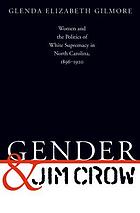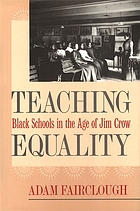Useful Tips
- Tip 1: Once you have located a book on your topic click on the subject headings of the catalog record. This can lead you to additional books on the same topic.
- Tip 2: Look to see if the catalog record has a summary or table of contents of the book and is available in other editions.
- Tip 3: If a record says networked resource it is usually available online.
- Tip 4: When doing keyword searching, try combining keywords/phrases. Be aware of the differences between broad and narrower, search:
Selected Books
-
 Signs of the Times: The Visual Politics of Jim Crow
by
Call Number: Africana Library E185.61 .A164 2010Signs of the Times traces the career of Jim Crow signs―simplified in cultural memory to the “colored/white” labels that demarcated the public spaces of the American South―from their intellectual and political origins in the second half of the nineteenth century through their dismantling by civil rights activists in the 1960s and ’70s. In this beautifully written, meticulously researched book, Elizabeth Abel assembles a variegated archive of segregation signs and photographs that translated a set of regional practices into a national conversation about race.
Signs of the Times: The Visual Politics of Jim Crow
by
Call Number: Africana Library E185.61 .A164 2010Signs of the Times traces the career of Jim Crow signs―simplified in cultural memory to the “colored/white” labels that demarcated the public spaces of the American South―from their intellectual and political origins in the second half of the nineteenth century through their dismantling by civil rights activists in the 1960s and ’70s. In this beautifully written, meticulously researched book, Elizabeth Abel assembles a variegated archive of segregation signs and photographs that translated a set of regional practices into a national conversation about race. -
Jim Crow New York: A Documentary History of Race and Citizenship, 1777-1877 by
Call Number: Africana Library E185.93.N56 J56x 2003Jim Crow New York introduces students and scholars alike to this watershed event in American political life. This action crystallized the paradoxes of free black citizenship, not only in the North but throughout the nation: African Americans living in New York would no longer be slaves. But would they be citizens? The text is further enhanced by extensive introductory essays and headnotes, maps, illustrations, and a detailed bibliographic essay. -
Managing White Supremacy: Race, Politics, and Citizenship in Jim Crow Virginia by
Call Number: Africana Library F235.A1 S65x 2002Tracing the erosion of white elite paternalism in Jim Crow Virginia, Douglas Smith reveals a surprising fluidity in southern racial politics in the decades between World War I and the Supreme Court's 1954 Brown v. Board of Education decision. Smith draws on official records, private correspondence, and letters to newspapers from otherwise anonymous Virginians to capture a wide and varied range of black and white voices. African Americans emerge as central characters in the narrative, as Smith chronicles their efforts to obtain access to public schools and libraries, protection under the law, and the equitable distribution of municipal resources. -
 Gender and Jim Crow: Women and the Politics of White Supremacy in North Carolina, 1896-1920
by
Call Number: Olin Library E185.93.N6 G55x 1996This classic work helps recover the central role of black women in the political history of the Jim Crow era. Glenda Elizabeth Gilmore explores the pivotal and interconnected roles played by gender and race in North Carolina politics from the period immediately preceding the disfranchisement of black men in 1900 to the time black and white women gained the vote in 1920. Gilmore argues that while the ideology of white supremacy reordered Jim Crow society, a generation of educated black women nevertheless crafted an enduring tradition of political activism.
Gender and Jim Crow: Women and the Politics of White Supremacy in North Carolina, 1896-1920
by
Call Number: Olin Library E185.93.N6 G55x 1996This classic work helps recover the central role of black women in the political history of the Jim Crow era. Glenda Elizabeth Gilmore explores the pivotal and interconnected roles played by gender and race in North Carolina politics from the period immediately preceding the disfranchisement of black men in 1900 to the time black and white women gained the vote in 1920. Gilmore argues that while the ideology of white supremacy reordered Jim Crow society, a generation of educated black women nevertheless crafted an enduring tradition of political activism. -
 Teaching Equality: Black Schools in the Age of Jim Crow
by
Call Number: Olin Library LC2741 F35 2001In Teaching Equality, Adam Fairclough provides an overview of the enormous contributions made by African American teachers to the black freedom movement in the United States. Beginning with the close of the Civil War, when “the efforts of the slave regime to prevent black literacy meant that blacks associated education with liberation, Fairclough explores the development of educational ideals in the Black community up through the years of the civil rights movement.
Teaching Equality: Black Schools in the Age of Jim Crow
by
Call Number: Olin Library LC2741 F35 2001In Teaching Equality, Adam Fairclough provides an overview of the enormous contributions made by African American teachers to the black freedom movement in the United States. Beginning with the close of the Civil War, when “the efforts of the slave regime to prevent black literacy meant that blacks associated education with liberation, Fairclough explores the development of educational ideals in the Black community up through the years of the civil rights movement.
Keywords/Phrases
- Jim Crow
- Jim Crowism
- African Americans and Segregation
- Racism
- Race Relations
- Civil Rights
- Laws and Jim Crow